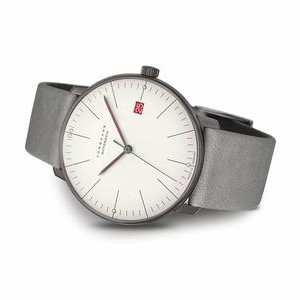Your Cart is Empty

The Junghans max bill Automatic provides a view of the internal workings for the first time
– as well as the layout of the Bauhaus itself.
The self-winding watch being unveiled by Junghans to commemorate the 100th anniversary of Bauhaus could hardly be more modest, despite its extreme eloquence. As a classic three-handed watch, the max bill Automatic embodies the essential aspects envisioned by product designer Max Bill – optimum readability of the time.
Max Bill himself studied at the Bauhaus, which was founded exactly 100 years ago. After arriving in Dessau in 1927 and laying eyes on the Bauhaus building for the very first time, he described his first impression as "something never seen before: white walls and huge dark glass façades with the student residence at the forefront and the balcony doors accentuated in red lead."
The feeling of exhilaration experienced by Max Bill upon encountering the Bauhaus is reflected in the to 1,000 watches limited edition Junghans max bill Automatic in 2019. This watch bears the fundamental ideas ingrained in the very fabric of the Bauhaus. The matt silver dial commemorates the white walls of the building in Dessau, and the anthracite coloured case is representative of the striking façade. Designed in the colour of the architects, the grey strap is inspired by the construction element of the Bauhaus: concrete. Guaranteeing ideal readability thanks to their clear and simplistic form, the red hands mirror the colour design of the famous red doors of the Bauhaus in Dessau. A hue which is even more prominent in the red date wheel.
The back of the watch will prove a true journey through time for enthusiasts and admirers of the Bauhaus. With its large windowed façade, the Bauhaus building is impressively represented on the glass case back– at the same time allowing a view of the mechanical movement through a window steeped in history. The red accentuated here is taken directly from the renowned red door of the Bauhaus building itself.
The Junghans max bill Automatic 100 Jahre Bauhaus – Representative of 100 years of design history.
max bill Automatic 100 Jahre Bauhaus
Features
|
027/4901.02 Limited to: 1000 watches |
Movement: Self-winding movement J800.1 with a power reserve of 38 hours
Case: Stainless steel anthracite matt PVD-coated,
Ø 38.0 mm, height 9.7 mm, convex sapphire crystal with anti-reflection coating on both sides, 4-times screwed case back with mineral crystal and printed Bauhaus logo providing partial views of the movement
Dial: Matt silver-plated dial, luminous dots
Hands: Hands with environmentally-friendly Superluminova luminous substance
Strap: Grey calf leather strap with PVD-coated buckle
Water-resistance: Up to 3 bar
Special feature: Date wheel and luminous substance in red
Junghans – Live your style
Junghans has been giving a face to time for over 150 years. The attention to detail, the high demands on design and quality and generations of technical expertise have characterised the products of Uhrenfabrik Junghans since it was founded in 1861. Values that form the foundations for the success story of the company from Schramberg in the Black Forest. In 1903 Junghans was the largest clock manufacturer in the world, with over 3,000 employees. The development of precision movements made the company the largest German manufacturer of chronometers in 1951 and the third largest worldwide in 1956. In 1972 Junghans was the official timekeeper of the Olympic Games in Munich, setting new standards in timekeeping. After an eventful and turbulent company history, the Schramberg businessmen Dr. Hans-Jochem and Hannes Steim became the new proprietors of the venerable company in 2009, ushering in a new era of growth. Junghans still produces all of its watches on the historical company site. In 2018 the terrace building has been revived for its 100th birthday. In this monument to industrial architecture, long the light-flooded centrepiece of Junghans watch production, the tradition of watch and clockmaking in the Black Forest can be experienced in the form of a museum. The current collection also references the long tradition of the company in design and watchmaking - transported to the present in contemporary form. For example, with the Meister watches, which have been manufactured since the 1930s, or the timepieces of Max Bill. These Bauhaus classics were first created in 1956 in collaboration with the Swiss designer – and are still produced to his designs in almost unaltered form today. In 1990 Junghans set new standards with the invention of the first radio-controlled wristwatch – a technology that is making its mark once again in 2018 with a new generation of intelligent, Schramberg-made radio-controlled movements of great precision and accuracy. The clear design language of the Junghans watches is a constant factor throughout the history of the company. The latest indication of this can be found in the stylish models of the FORM family, with their reduced simplicity. For over 150 years now Junghans watches have combined watchmaking and design expertise on the wrist. Style made tangible.
Credit "https://www.junghans.de/en/junghans-news-press/artikel0/637/News/detail.html"
Comments will be approved before showing up.